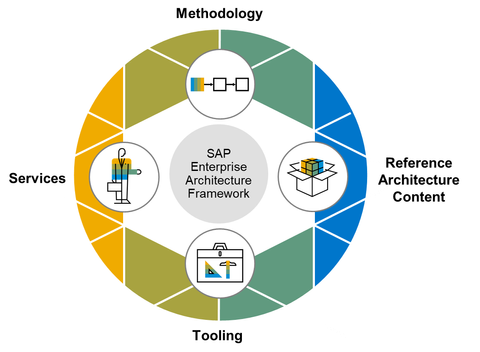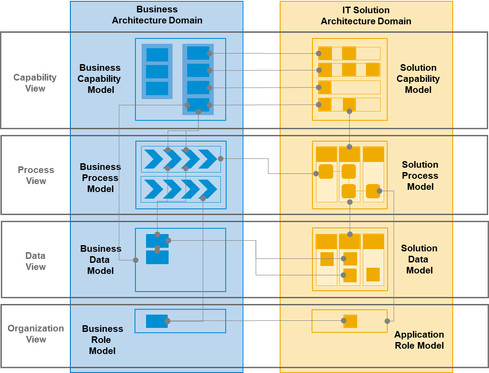
- SAP Community
- Groups
- Interest Groups
- Enterprise Architecture
- Blog Posts
- SAP Enterprise Architecture Framework
- Subscribe to RSS Feed
- Mark as New
- Mark as Read
- Bookmark
- Subscribe
- Printer Friendly Page
- Report Inappropriate Content
This article will provide further insights into the SAP Enterprise Architecture Framework which was presented by Andreas Poth at the SAP Enterprise Architecture Global Summit (March ‘22) and the TOGAF® Standard 1010th Edition – Launch event (May ‘22).
The need for a common and aligned framework
Over the course of time, we have seen as Enterprise Architects in SAP Business Transformation Services, both SAP internal as well in the interaction with customers and partners, that different methodologies, artifacts, and approaches are used in architecture engagements. With the creation of a reference architecture the need for a common Enterprise Architecture Framework at SAP was obvious as different departments within the SAP organization produce and consume the content of the reference architecture. Only one common “language” and approach would ensure that information can be leveraged in an efficient and effective way both inside and outside the organization.
SAP Enterprise Architecture Framework
The SAP Enterprise Architecture Framework is centered around the following four cornerstones:
Methodology: Proven, TOGAF and industry standards-based EA methodology, widely adopted throughout SAP
Reference Architecture Content: SAP Reference Business and Solution Architecture mapping Business and SAP IT Solutions
Tooling: Set of customer-facing and SAP-internal Enterprise Architecture tools
Services: Standardized SAP EA Services to support customer transformation
Figure 1 – SAP Enterprise Architecture Framework
SAP Enterprise Architecture Methodology
With the SAP Enterprise Architecture Methodology, we support a sub-set of the TOGAF® Version 10 Architecture Development Method (ADM) phases. Beside requirements management and the preliminary phase, the focus is on the
- Architecture Vision
- Business Architecture
- Application & Data Architecture (Information System Architecture in TOGAF terms)
- Technology Architecture
- Opportunities and Solutions
- Migration Planning
We foresee a set of recommended artifacts for each phase proven widely in architecture engagements. These recommended artifacts are complemented by additional artifacts which can be used in a given architectural context on a per-need basis. At the same time, the framework is open for extensions.
The following graph outlines SAP’s customer facing (SAP Presales and SAP Consulting) enterprise architecture development process based on TOGAF® ADM with SAP-recommended artifacts. Although it looks visually like a waterfall model, it is highly iterative.
Figure 2 – SAP’s customer facing architecture development process based on TOGAF® ADM with SAP-recommended artifacts
The overview of the recommended and optional artifacts is visualized in form of a Metro Map (see figure 3), which depicts the architecture development phases in conjunction with the artifacts rendered as stops on the metro map.
Please note that the arrows in the figure outline rather a natural flow than a strict sequence of artifacts. Majority of the artifacts are based on the TOGAF Version 10 standard.
Beside the TOGAF based artifacts, we complemented our framework with additional artifacts which have been proven to be successful in the stakeholder interaction for example the Business Model Canvas (now in its latest version as Sustainable Business Model Canvas) or the Application Use-Case Diagram which supports a Design Thinking centric and use case driven approach.
Figure 3 - SAP Enterprise Architecture Methodology – Metro Map
Reference Architecture Content
Another highlight of the SAP Enterprise Architecture Framework are the Reference Business Architecture (RBA) and the Reference Solution Architecture (RSA), as both provide standardized and authored reference content provided by SAP.
The SAP Reference architecture can be applied in SAP’s Customer Facing EA ADM and supports multiple of the artifacts outlined in figure 3.
The Reference Business Architecture and Reference Solution Architecture are structured alongside the following four architecture views:
- Capability View
- Process View
- Data View
- Organization View
Figure 4 - SAP Enterprise Architecture Methodology - Overview of core domains & models
The four views cover a business and IT related model and allow the navigation between these two perspectives. Having said that, navigation between different views and respective entities adds significant value, as the content of the reference architecture is an official and authored content.
For further information on the Reference Architecture, please refer to the blog of Maria Goltz SAP Reference Architecture Content: An Overview
Enterprise Architecture Tooling
The SAP Enterprise Architecture Framework is featured by a set of SAP externally-facing and internal tools, among these are
- Signavio (with the One Process Acceleration Layer)
- Product Map Generator (SAP internal and available in SAP engagements with SAP)
- Roadmap Explorer
- SAP API Business Hub
- SAP Trust Center
Enterprise Architecture Service
The SAP Enterprise Architecture Framework comes along with a set of predefined enterprise architecture consulting service. Following an extract of the service catalog incl. the most relevant service offerings:
Architecture Point of View
| With the architecture point of view (APoV), customers can get support in an early phase of their project on how to approach their long-term transformation needs. The service contains components for various topics like the analysis of solution-specific transformation routes, or initial evaluation of adopting SAP S/4HANA, initial guidance in the analytics and data management area, specific solution and technology focused topics, or a deep-dive into SAP’s enterprise architecture and road mapping approach. |
Innovation Strategy and Roadmap | This service component helps develop a multi-year strategic road map that addresses your digital transformation needs. Starting from strategy and objectives of business and IT, it delivers a long-term target architecture that is based on current and future needs and comprises relevant functionality of SAP S/4HANA, SaaS applications, and SAP Business Technology Platform features. Proposed enablers and initiatives are prioritized by business value. |
Target Architecture Assessment | When starting digital transformations, SAP customers need to define the target architecture and the roadmap to layout how to get there. The target architecture assessment focuses on existing artifacts that the project team has produced and reviews them against the industry reference architecture and the SAP road map. As a result, the necessary adjustments to the target application architecture and transition plans are jointly evaluated. |
Architecture Transformation | This service provides a comprehensive planning package from strategy down to architecture transformation planning. It supports the customer in developing a multiyear digital transformation road map including specific technical architectures, sizing efforts, required IT infrastructure, mapped SAP software components, and best practices for implementation, deployment, and technical risk mitigation |
Integration Strategy | This service component supports you creating your integration strategy when you are planning a system conversion or new implementation for SAP S/4HANA, or implement software-as-a-service (SaaS) cloud solutions from SAP. It includes reviewing the existing and planned integration landscape, SAP Integration Solution Advisory Methodology, and building overall integration strategy. |
Architecture Governance | Architecture governance focuses on helping ensure the enterprise architecture is set up and conducted properly. It is less about control and strict adherence to rules and more about guidance and effective usage of resources, tapping into best practices and tools to make the transformation a success. The architecture governance service helps customers in early phases or even before their transformation has started, to establish an appropriate framework to create or evolve their enterprise architecture. It focuses on how to manage enterprise architecture and provides direction on planning to make the transformation a success and establish the intelligent enterprise in incremental steps. |
As every organization is unique in its setup and level of maturity, individual services can be tailored to specific needs. This happens in a lego-like, modularized approach. The following services build the modular foundation alongside the known TOGAF ADM phases:

The outlined services can be booked individually and are delivered by experienced SAP Enterprise Architects around the world. For further information, please get in touch with your SAP Account team.
Conclusion
The SAP Enterprise Architecture Framework is a comprehensive Framework which combines a sound methodology with a valuable reference architecture featured by a set of tools and supported by service offerings. It offers the opportunity to create a common language and practices within the SAP Enterprise Architecture community with the potential to accelerate and streamline enterprise architecture engagements.
Interested in learning more about the SAP Enterprise Architecture Framework?
If you are interest to learn more about the new SAP Enterprise Architecture Framework you can book our new training offering which is described in this blog: SAP Enterprise Architecture Training - SAP Community Groups
You must be a registered user to add a comment. If you've already registered, sign in. Otherwise, register and sign in.
-
Application Architecture
23 -
Business Architecture
33 -
Data Architecture
19 -
Emerging Trends
18 -
Enterprise Architecture
52 -
Frameworks
18 -
Hybrid and Multi Cloud
3 -
Innovation
14 -
Integration Architecture
16 -
Portuguese
1 -
Roadmaps
12 -
Skills and Learning
26 -
Solution Architecture
22 -
Sustainability
3 -
Technology Architecture
21 -
Tools
12
| User | Count |
|---|---|
| 5 | |
| 4 | |
| 2 | |
| 1 | |
| 1 | |
| 1 | |
| 1 | |
| 1 | |
| 1 | |
| 1 |





